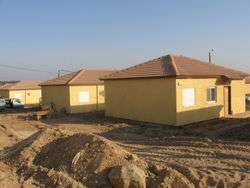Nitzan
| Nitzan | |
|---|---|
| Hebrew transcription(s) | |
| • official | Nizzan |
|
| |
 Nitzan | |
| Coordinates: 31°44′7.79″N 34°37′29.28″E / 31.7354972°N 34.6248000°ECoordinates: 31°44′7.79″N 34°37′29.28″E / 31.7354972°N 34.6248000°E | |
| District | Southern |
| Council | Hof Ashkelon |
| Founded | 1949 |
| Population (2015)[1] | 1,853 |


Nitzan (Hebrew: ניצן, lit. Flower bud) is a religiously observant communal settlement in southern Israel. Located among the Nitzanim sand dunes north of Ashkelon, it falls under the jurisdiction of Hof Ashkelon Regional Council. In 2015 it had a population of 1,853, including a large concentration of Bnei Menashe (10–20% of the population) from the India/Myanmar border region of India.
History
The first settlement on Nitzan's current grounds was the kibbutz of Nitzanim in 1943. The kibbutz was established after the Jewish National Fund purchased a 400-acre (1.6 km2) plot of land and a large house known as the "mansion" in 1942.[2] The first residents were immigrants, some of whom were Holocaust survivors. It later absorbed more immigrants from Poland and Romania. The kibbutz was conquered by Egypt during the 1948 Arab–Israeli War, but recaptured by Israel towards the end of the conflict. However, the kibbutz was re-established 3 kilometers (1.9 mi) to the south. The original site was used instead for a new youth village, which was established in 1949 and named Nitzanim Youth Village.
The youth village closed in 1990 and the site was used to establish the modern communal settlement of Nitzan. By 1995 it had a population of 105. It experienced rapid expansion in the mid-2000s after being selected to temporarily house a large group of families evacuated from Gush Katif as part of the disengagement plan. 500 temporary caravillas were constructed on the eastern end of Nitzan (an area that became Nitzan Bet), and 250 more were ordered by the Israeli Government.
Several environmental organisations objected to the new construction, which increased Nitzan's area by four-and-a-half times, fearing damage to the fragile sand dune ecosystem. The neighbourhood has also been the target of criticism from the settlers, as well as Israeli human-rights groups,[3][4] citing a lack of adequate housing and facilities. They argue that governmental negligence resulted in a housing shortage, forcing large families to separate into multiple caravillas, and that basic infrastructure like a youth area, nursery, and synagogue were absent.
On 12 July 2012, the organization United With Israel` planned to deliver bomb shelters to the residents of Nitzan. It has become a major event for the residents of Nitzan, whose children needed kindergarten bomb shelters. The event would include children painting the shelters with murals, supervised by a professional mural artist.[5]
References
- ↑ "List of localities, in Alphabetical order" (PDF). Israel Central Bureau of Statistics. Retrieved 16 October 2016.
- ↑ Women of Valor Center - Nitzanim Society for the Preservation of Israel Heritage sites Archived October 4, 2011, at the Wayback Machine.
- ↑ Nir Hasson (1 August 2005). "First families move to Nitzan homes; others opt for tents". Haaretz. Retrieved 8 August 2014.
- ↑ Yuval Yoaz (16 May 2005). "Nature Society asks Mazuz to halt Nitzan construction". Haaretz. Retrieved 10 August 2014.
- ↑ "Kindergarten Bomb Shelters in Nitzan". United with Israel. 16 July 2014. Retrieved 10 August 2014.